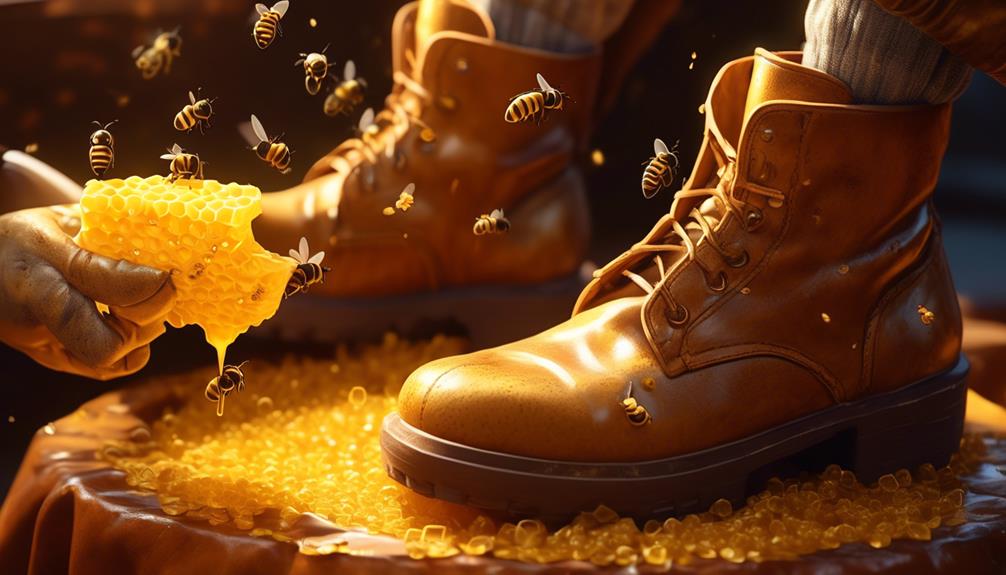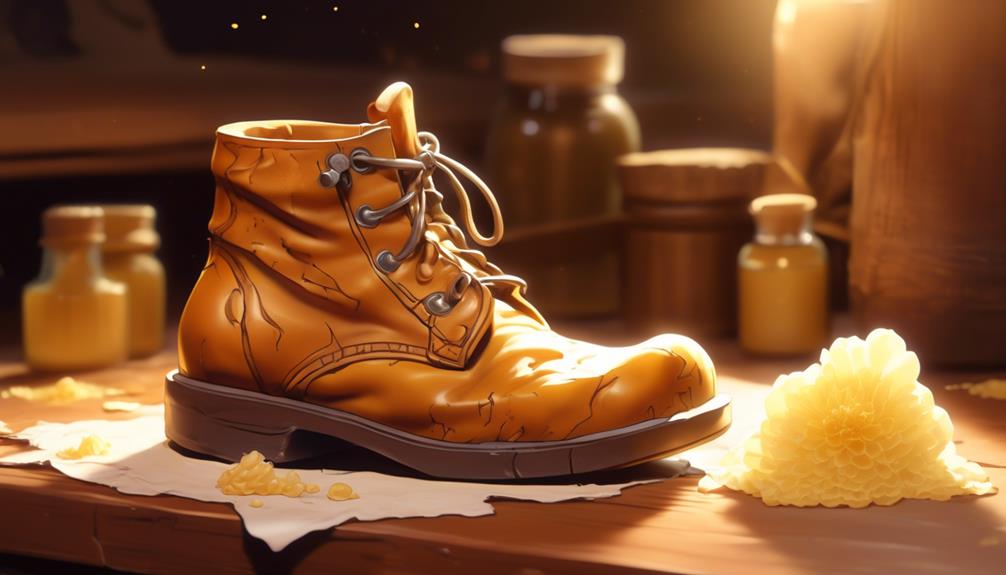Journey with us as we unveil how beeswax can transform and protect your cherished leather items, and discover which types it may not suit.

How to Use Beeswax on Leather?
Have you ever wondered how to breathe new life into your favorite leather items? Beeswax is your not-so-secret weapon. Known for its incredible waterproofing and conditioning abilities, beeswax is easily applied to leather, offering protection and longevity.
Whether it's your cherished leather boots, your go-to handbag, or the vintage leather jacket you treasure, beeswax could be the key to their revival and maintenance. We'll discuss how to prepare your leather items, apply the beeswax, and care for your now beeswax-treated items.
However, it's important to note that although beeswax works wonders, there are certain types of leather that it doesn't quite mesh with. So, which are they?
Key Takeaways
- Beeswax is a natural wax that offers protection, durability, and a lustrous sheen to leather.
- Beeswax acts as a conditioner and prevents leather from drying out and cracking.
- Beeswax provides a protective layer against moisture, dirt, and UV rays.
- Full-grain leather is the best candidate for beeswax treatment, while caution is advised with more delicate leathers like suede and nubuck.
Understanding the Benefits of Beeswax

Diving into the world of beeswax, you'll find it's an incredibly beneficial substance for leather, offering protection, durability, and a lovely sheen. It's a natural wax produced by honey bees, and when applied to leather, it serves as a fantastic conditioner.
Beeswax provides a protective layer that shields your leather goods from moisture and dirt, ensuring they last longer. It's a waterproofing agent, so you won't have to worry about getting caught in a sudden downpour. This protective layer doesn't just safeguard against water, but also against harmful UV rays, which can cause your leather items to fade or crack over time.
Further, beeswax enhances the durability of your leather goods. It nourishes the leather, preventing it from drying out and cracking, thereby extending its lifespan. It's an excellent tool for leather restoration, capable of bringing back the life to old, worn-out leather items.
And let's not forget the aesthetic appeal. Beeswax imparts a rich, lustrous sheen to your leather products, making them look even more luxurious. So, not only does it protect and strengthen, but it also beautifies. You see, beeswax truly is a wonder for your leather possessions.
Types of Leather Suitable for Beeswax

While beeswax offers impressive benefits for leather, it's essential to understand that not all types of leather are best suited for this treatment. Let's delve into the specific types of leather that work best with beeswax and why.
Full-grain leather, being the highest quality and most natural form of leather, is an excellent candidate for beeswax treatment. It's robust and durable, thus can withstand the beeswax application without losing its quality. The beeswax enhances the lifespan of full-grain leather by providing a protective layer against water, dirt, and wear.
Top-grain leather, another high-quality type, also responds well to beeswax. It's slightly less durable than full-grain but still benefits from the added protection. The wax can improve the leather's resistance and longevity.
When it comes to suede or nubuck leather, however, caution is advised. These types are more delicate and porous. An application of beeswax might darken the material and clog its pores, damaging its characteristic texture.
Preparing Your Leather for Beeswax

Before applying beeswax, it's crucial to properly prepare your leather to ensure an effective treatment and preserve its quality. Start with cleaning your leather goods. You can do this by using a lightly dampened cloth to wipe off any visible dust or dirt. Avoid soaking the leather, as this can cause it to crack or warp.
After cleaning, it's time to condition your leather. Apply a small amount of leather conditioner to a soft cloth and gently work it into the leather. This not only helps to restore moisture but also makes the leather more receptive to the beeswax. Always apply the conditioner in a circular motion and let it dry fully before proceeding to the next step.
Lastly, ensure your leather is completely dry before applying beeswax. Any moisture left can hinder the beeswax from penetrating the leather properly. You can leave your leather to air dry in a cool, well-ventilated area. Avoid direct sunlight or heat sources as they can cause the leather to dry out and crack.
Step-by-Step Beeswax Application Guide

With your leather now prepared and dry, you're ready to move onto the main event – applying beeswax to your leather. It's a straightforward process, but you'll need to take your time to ensure a uniform application that penetrates every pore of the leather surface.
Here's a step-by-step guide to help you through the process:
Step | Action | Tip |
|---|---|---|
1 | Gather Materials | You'll need beeswax, a clean cloth, and a hairdryer. |
2 | Apply Beeswax | Using the cloth, rub beeswax onto the leather in a circular motion. |
3 | Heat Beeswax | Use the hairdryer to melt the beeswax into the leather. Keep it moving to avoid overheating. |
4 | Let it Soak | Allow the leather to soak in the beeswax overnight for a deep conditioning. |
5 | Buff to Shine | In the morning, buff the leather with a clean, soft cloth to reveal a subtle shine. |
Caring for Beeswax-Treated Leather

Now that you've successfully applied beeswax to your leather, it's crucial to understand how to properly maintain this finish to ensure long-lasting protection and shine.
Beeswax-treated leather needs gentle care, so avoid exposing it to harsh elements or sharp objects that could scratch the surface.
To keep the leather in top shape, clean it regularly with a soft, dry cloth. Don't use any harsh chemical cleaners, as they can strip away the beeswax and damage the leather. If the leather gets dirty, you can use a mild soap and water solution to remove the dirt. Always test this solution on a small, hidden area first to ensure it won't discolor the leather.
If you notice the beeswax finish starting to dull or wear off, it's time to reapply the beeswax. This can be done every few months, or as needed. Simply follow the same steps you did when you first applied the beeswax. Remember, a little goes a long way when it comes to beeswax.
Troubleshooting Common Beeswax Issues

Despite your best efforts, you might encounter some issues when working with beeswax on leather. But don't worry, there are solutions to these common problems.
One problem you may face is the beeswax not adhering properly to the leather. If this happens, it's likely because the leather wasn't clean when you applied the wax. Wipe the leather clean with a damp cloth and reapply the beeswax.
Another common issue is the beeswax layer being too thick or uneven. This often occurs when you've applied too much wax or didn't spread it evenly. To solve this, lightly reheat the waxed surface with a hairdryer and smooth it out using a clean, dry cloth.
You might also find that the beeswax isn't absorbing into the leather. In this case, the leather might be too cold. Warm the leather with a hairdryer before applying the beeswax, and it should absorb more readily.
Frequently Asked Questions
Can Beeswax Change the Color of My Leather Item?
Yes, beeswax can slightly darken the color of your leather item. When you apply it, you're adding a layer that penetrates the leather, enhancing its natural tones. It's a bit like wetting a stone – the colors become deeper and richer.
Can I Use Beeswax on Synthetic Leather or Faux Leather Materials?
You can use beeswax on synthetic or faux leather, but it won't absorb as it does with real leather. Instead, it'll create a protective layer on the surface. However, it could alter the finish or feel of the material, so it's important to test it on a small, inconspicuous area first.
Beeswax isn't typically recommended for synthetic leather, but it's not harmful if you're cautious and understand the potential effects.
How Often Should I Reapply Beeswax to Keep My Leather in Good Condition?
You should reapply beeswax to your leather items every six months to ensure they stay in good condition.
However, if you're frequently using the item, like a pair of boots or a handbag, you might need to apply more often.
It's all about observing the leather. If it's looking dry or losing its luster, it's time for a touch up.
Is There a Specific Brand of Beeswax That Is Recommended for Leather Treatment?
There isn't one specific brand of beeswax that's universally recommended for treating leather. What's important is to pick a product that's pure, without added chemicals.
You'll often find beeswax mixed with other natural ingredients like jojoba oil or carnauba wax, which can be beneficial for leather.
Just remember, it's not the brand that counts, but the quality and purity of the beeswax.
Always read labels carefully before making your choice.
Can Beeswax Cause Any Allergic Reactions or Health Issues?
Yes, it's possible to have an allergic reaction to beeswax. Symptoms may include itching, swelling, and redness. If you're handling beeswax and you notice these symptoms, stop use immediately. It's always a good idea to do a patch test on your skin before using a new product.
Health issues are rare, but can include respiratory problems if you're inhaling the fumes. Always use beeswax in a well-ventilated area.
Conclusion
So, there you have it. Beeswax is a fantastic, natural way of caring for your leather goods. Whether you're preparing your leather for the first time or troubleshooting any beeswax issues, it's all about understanding the process and the materials involved.
Remember, proper care and maintenance will ensure your leather stays looking good and lasts longer. Give it a try, and you'll quickly see the benefits of using beeswax on your leather items.



